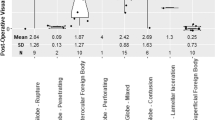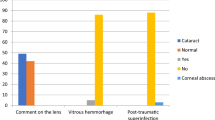Abstract
Purpose
Ocular blast injuries in the military setting are particularly associated with significant maxillofacial trauma and/or brain injury. The opportunity to perform a comprehensive ophthalmic evaluation is frequently limited in the acute multiple trauma scenario. We aim to describe the relationship between the clinical effects of acute ocular and orbital blast trauma with the findings on computerised tomography (CT).
Methods
This was a retrospective consecutive case series of all soldiers with facial and/or suspected ocular injuries. A total of 80 eyes that had suffered blast injuries of varying severity were studied. Assessment of orbital and ocular CT images were performed by military consultant radiologists. A comparison was made with actual clinical findings. Statistical analysis was performed using Fisher's exact test.
Results
No pathological findings were described in 37 of the 80 eyes imaged by orbital and ocular CT scans. Clinically, these eyes and orbits were all found to be intact, or had minor trauma. All foreign bodies and penetrating eye injuries were successfully diagnosed by CT. Absence of an orbital fracture did not rule out a globe injury. However, a corneal or scleral defect was less likely when an orbital fracture was absent.
Conclusion
The eye is a delicate structure prone to injury that requires urgent repair if breached. It is difficult to assess thoroughly in the unconscious or distressed patient. In this context, CT imaging is invaluable to be able to make a relatively confident prediction of clinical findings and decide upon the necessity for acute ophthalmic surgical intervention.
Similar content being viewed by others
Log in or create a free account to read this content
Gain free access to this article, as well as selected content from this journal and more on nature.com
or
Change history
18 March 2015
This article has been corrected since Advance Online Publication and a corrigendum is also printed in this issue.
References
Cheung CA, Rogers-Martel M, Golas L, Chepurny A, Martel JB, Martel JR . Hospital-based ocular emergencies: epidemiology, treatment, and visual outcomes. Am J Emerg Med 2013; 32 (3): 221–224, pii: S0735-6757.
Wagner PJ, Lang GK . Mechanical ocular trauma. Curr Opin Ophthalmol 1996; 7 (4): 57–64.
May DR, Kuhn FP, Morris RE, Witherspoon CD, Danis RP, Matthews GP et al. The epidemiology of serious eye injuries from the United States Eye Injury Registry. Graefes Arch Clin Exp Ophthalmol 2000; 238 (2): 153–157.
Belkin M . Ocular war injuries in the Yom Kippur war. J Ocul Ther Surg 1983; 2: 40–49.
Gombos GM . Ocular war injuries in Jerusalem. Am J Ophthalmol 1969; 68: 474–478.
Breeze J, Allanson-Bailey LS, Hunt NC, Midwinter MJ, Hepper AE, Monaghan A et al. Surface wound mapping of battlefield occulo-facial injury. Injury 2012; 43: 1856–1860.
Scott RAH, Blanch RJ, Morgan-Warren PJ . Aspects of ocular war injuries. Trauma 2014; 17 (2): 83–92.
Woodcock MG, Scott RA, Huntbach J, Kirkby GR . Mass and shape as factors in intraocular foreign body injuries. Ophthalmology 2006; 113 (12): 2262–2269.
Imran S, Amin S, Daula MIH . Imaging in Ocular Trauma Optimizing the Use of Ultrasound and Computerised Tomography. Pak J Ophthalmol 2011; 27 (3): 146–151.
Lee HJ, Jilani M, Frohman L, Baker S . CT of orbital trauma. Emerg Radiol 2004; 10: 168–172.
Andreoli MT, Yiu G, Hart L, Andreoli CM . B-scan ultrasonography following open globe repair. Eye (Lond) 2014; 28 (4): 381–385.
Dunkin JM, Crum VC, Swanger RS, Bokhari SAJ . Globe trauma. Semin Ultrasound CT MR 2011; 32: 51–56.
Kuhn F, Maisiak R, Mann L, Mester V, Morris R, Witherspoon CD . The ocular trauma score (OTS). Ophthalmol Clin North Am 2002; 15: 163–165.
Schmidt GW, Broman AT, Hindman HB . Vision survival after open globe injury predicted by classification and regression tree analysis. Ophthalmology 2008; 115: 202–209.
Ainbinder DJ, Mazzoli RA, Raymond WR, Hansen EA, Sanford EG . Ophthalmic care of the combat casualty, Ocular trauma scores. Section 2, chapter 6.
Joseph DP, Pieramici DJ, Beauchamp NJ . Computed tomography in the diagnosis and prognosis of open-globe injuries. Ophthalmology 2000; 107 (10): 1899–1906.
Kubal WS . Imaging of orbital trauma. Radiographics 2008; 28 (6): 1729–1739.
Lincoff H, Weinberger D, Reppucci V, Lincoff A . Air travel with intraocular gas. I. The mechanisms for compensation. Arch Ophthalmol 1989; 107: 902–906.
Chaudhry I, Shamsi F, Al-Harthi E, Al-Theeb A, Elzaridi E, Riley F . Incidence and visual outcome of endophthalmitis associated with intraocular foreign bodies. Graefes Arch Clin Exp Ophthalmol 2008; 246 (2): 181–186.
Colyer M, Weber E, Weichel E, Dick JS, Bower KS, Ward TP et al. Delayed intraocular foreign body removal without endophthalmitis during Operations Iraqi Freedom and Enduring Freedom. Ophthalmology 2007; 114 (8): 1439–1447.
Choovuthayakorn J, Hansapinyo L, Ittipunkul N, Patikulsila D, Kunavisarut P . Predictive factors and outcomes of posterior segment intraocular foreign bodies. Eye 2011; 25: 1622–1626.
Martin B, Ghosh A . Antibiotics in orbital floor fractures. Emerg Med J 2003; 20 (1): 66.
Pinto A, Brunese L, Daniele S, Faggian A, Guarnieri G, Muto M et al. Role of computed tomography in the assessment of intraorbital foreign bodies. Semin Ultrasound CT MR 2012; 33 (5): 392–395.
Kim SY, Lee JH, Lee YJ, Choi BS, Choi JW, In HS et al. Diagnostic value of the anterior chamber depth of a globe on CT for detecting open-globe injury. Eur Radiol 2010; 20 (5): 1079–1084.
Chodick G, Bekiroglu N, Hauptmann M, Alexander BH, Freedman DM, Doody MM et al. Risk of cataract after exposure to low doses of ionizing radiation: a 20-year prospective cohort study among US radiologic technologists. Am J Epidemiol 2008; 168: 620.
Acknowledgements
The study was carried out within the National Health Service (NHS). No extra financial support was sought or needed to complete the study. We would like to acknowledge the National Institute for Health Research Surgical Reconstruction and Microbiology Research Centre, Queen Elizabeth Hospital Birmingham.
Author information
Authors and Affiliations
Corresponding author
Ethics declarations
Competing interests
The authors declare no conflict of interest.
Rights and permissions
About this article
Cite this article
Chaudhary, R., Upendran, M., Campion, N. et al. The role of computerised tomography in predicting visual outcome in ocular trauma patients. Eye 29, 867–871 (2015). https://doi.org/10.1038/eye.2015.39
Received:
Accepted:
Published:
Issue date:
DOI: https://doi.org/10.1038/eye.2015.39
This article is cited by
-
Characteristics and scoring method of computed tomography in open-globe injuries
BMC Ophthalmology (2024)



